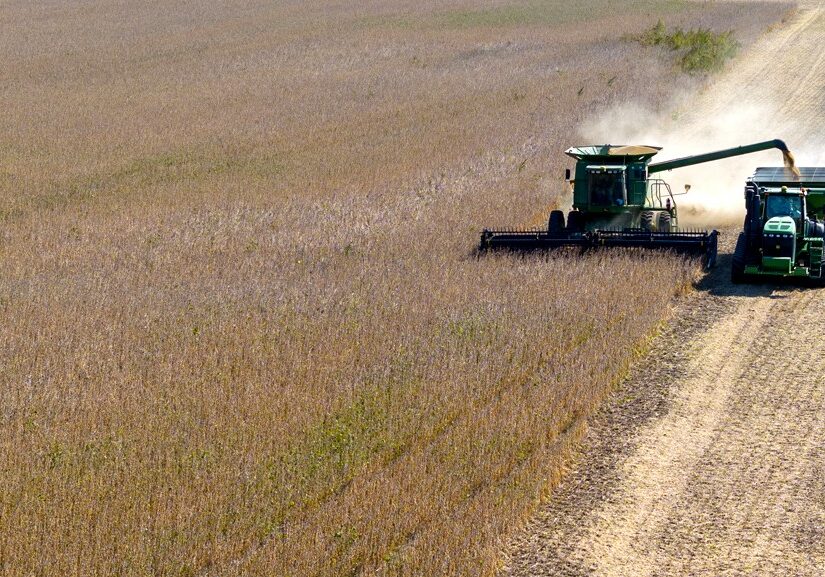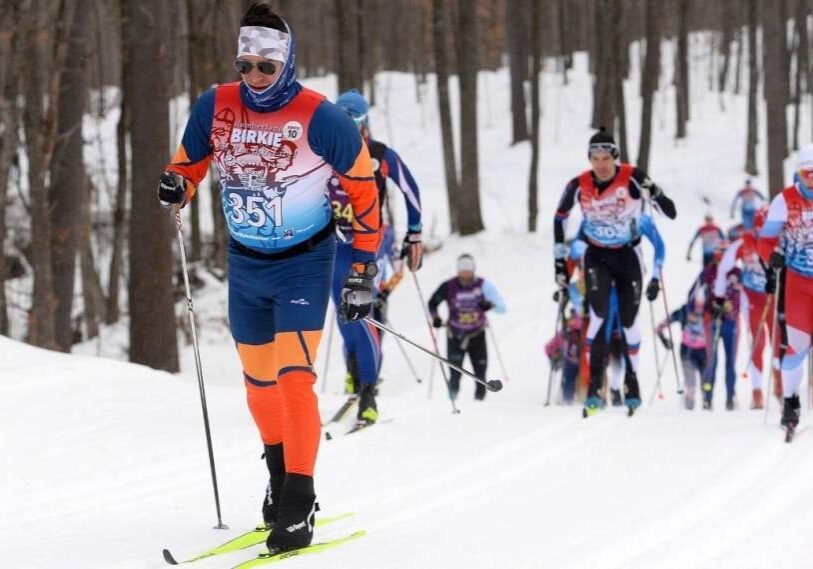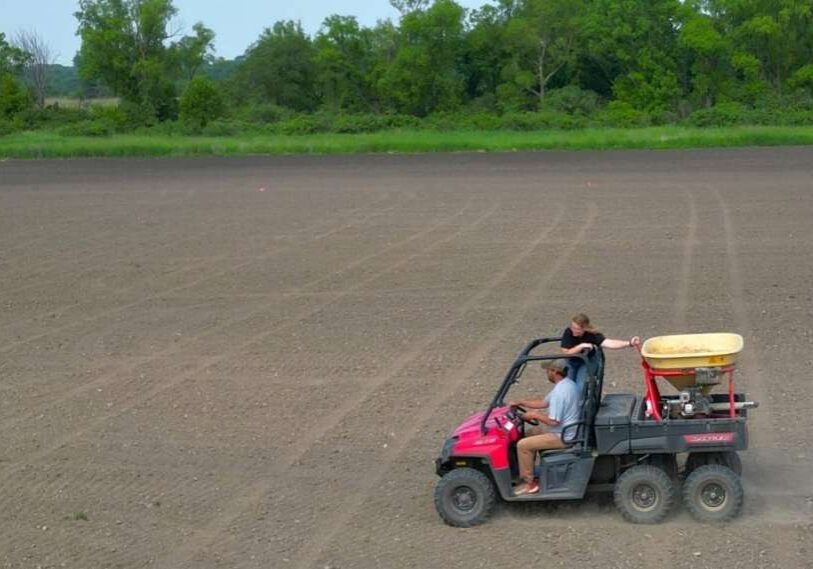Bold Vision, Deep Roots: Two Southeast Minnesota Nurseries Source Seed for Restoring Native Landscapes

WINONA & HOUSTON COUNTIES — As I step out of my car at Prairie Moon Nursery on an April morning, rain pelts the hilltop and a sideways gust of wind whips my umbrella inside out. Before reaching the door, I’m drenched. But rain and a muddy drive on Winona County 17 to the native seed company’s headquarters, north of Rushford, isn’t a problem after the past year of weird, dry weather and gritty gardening.
On the trip to Prairie Moon, I coursed through a narrow valley where small fields looked ready for a new season. Long parcels along a winding creek hinted at the presence of people and crops other than corn and beans, and I wondered if this was Wiscoy, the cooperatively owned land where Alan Wade and neighbors established Prairie Moon in 1982.
I soon learned it is.
Prairie Moon’s beginning
Inside, Becky Klukas-Brewer, Prairie Moon Nursery’s Director of Marketing, Sales and Service welcomes me and circles back to talk about Prairie Moon’s roots in the work of Illinois prairie restoration advocates Doug and Dot Wade.
Doug was a graduate student of Aldo Leopold, a respected professor at the University of Wisconsin-Madison, and author of A Sand County Almanac, the poetic environmental classic. Leopold advocated for commercial production of native species to facilitate ecological restoration on a large scale. Doug and Dot learned how to identify, collect, and document native plants from Leopold and passed that knowledge on to their son, Alan.
In 1982, in rural Winona County, Alan teamed up with neighbors to make a business selling native seeds. All were members of Wiscoy Valley Community Land Cooperative, an intentional community organized in 1976 around principles of collective land stewardship, social justice, and consensual decision-making.
In the beginning, bare root dormant plants were dug and stored under bales of hay to keep them cool prior to shipping. There was no office and most of the work was done on Alan Wade’s porch.
Today, a modern, thriving business
The commitment and friendly, hands-on approach of Prairie Moon’s founders is evident as Becky leads me through their facility.
In a bright, unpretentious room the sales team, a graphic designer, and administrative staff answer customer questions, take orders, design custom seed mixes, plan and manage on-site growing and harvesting, procure seed from seed company partners and contracted pickers, and manage team and business affairs.

Sales consultants like Laura play a primary role in Prairie Moon’s commitment to educate and support customers, who turn to the company’s website for planning, seed prep, planting and land management information, as well as ordering. (Photo by Nancy North)
They’re a focused bunch, smiling as Becky interrupts to introduce me, and ready to help. Posters of native plants, animals, and systems flow like patchwork around office spaces, catching my eye (and curiosity) as we move to seed preparation and shipping departments.
Getting 700+ native seed species to customers
In 2023, an addition to Prairie Moon’s headquarters made more room for shipping, receiving, warehousing and initial seed processing tasks.

In the new, expanded space, Arthur screens rough seed, removing husks and dry plant matter to produce clean seed for sale. Varied screen sizes on the rack in the background are used to clean seeds of many sizes. (Photo by Nancy North)

Seeds are tested, cataloged, labeled and stored in conditions that ensure germination, authenticity and location specificity. In this room, GeAnn selects and weighs seed according to customer order. (Photo by Nancy North)
As we move through the building, I sense openness.
“We look for ways to do better,” said Klukas-Brewer, the marketing director. “No one knows everything about native plant species and restoration practices, and there is no equipment designed just for native seed production. So, we continue to be creative, modify equipment, and keep an eye on improving.”

Melvin prepares orders for transport, selects a carrier, and ships product to customers. (Photo by Nancy North)
The native seed business sector is small with about 10 growers in Minnesota, five in Iowa, and five in Wisconsin. Based on location, culture, expertise, market demand and response, companies have evolved to serve various needs and customer bases.
With a network of growers across the Midwest, Prairie Moon offers the largest native plant collection available for retail sales in the United States. In addition to seeds, the nursery ships plants and bare root stock.

Adjacent to Prairie Moon’s greenhouse, Abby transplants Lobelia Cardinalis (cardinal flower) from starter trays to larger pots where they grow into plugs for use by gardeners. (Photo by Nancy North)

Potted plants are increasingly popular with Prairie Moon customers. Here, the greenhouse is just beginning to fill for spring shipping. (Photo by Nancy North)
Prairie Moon seeds, and bare root and potted plants make their way from Winona County to national parks, local government projects, corporate landscapes, schools, farms and home gardens. Prairie Moon Nursery is clear about its purpose: “We are dedicated to helping you be a part of the collective effort to nurture and sustain the living landscape.”

Native plants add beauty to homes and public areas, and their deep roots hold soil and naturally clean and protect water. (Photo by Nancy North)
As I turn to leave on this spring morning, I soak up a soft view, then drive south to Shooting Star Native Seeds, wondering how it is that two successful native seed companies grew up just 42 miles apart in southeast Minnesota.

After an April rain at Prairie Moon Nursery, dormant fields rest before a burst of spring growth. (Photo by Nancy North)
Next Stop: Shooting Star Native Seeds
In Spring Grove an afternoon squall forces a second dash to avoid a soaking. Upon arriving, Shooting Star Native Seeds’ Operations Director, Jessi Strinmoen, and President, Mark Udstuen, sit down to discuss their work and Shooting Star’s story.
Let’s give it a whirl!
“My father-in-law, Howard Deters, was a traditional farmer who was ready for a new challenge,” Mark begins. “So, in 1980, he, along with two partners, started a company named Sodko, selling sod to garden centers, landscapers, and eventually the Minnesota Department of Transportation (MnDOT). At the time, the MnDOT was in its infancy with native seeds.
“Howard and his partners, Jim Hunzeker and Jim Henzler, started seeing big bluestem and other native plant seeds in the bidding specs and thought, ‘Well, we’re farmers. We know how to grow corn and soybeans. Why don’t we just start growing natives? We have equipment, we have land, we know how to grow things. So, let’s give it a whirl.’”
That was 1989. They collected seed near the Mississippi River in Houston and neighboring Allamakee (Iowa) counties and that first tenth of a pound grew to half an acre, then two acres, then ten.
Eventually Shooting Star Native Seeds incorporated and Sodko split into two companies: Sodko, Inc. (installing prairie and erosion control) and Sodko Turf (growing and selling sod).
Now, Shooting Star Native Seeds provides over 300 species of sedges, rushes, grasses and wildflowers, much of which is grown on 1500 acres near Spring Grove and 1500 acres in other parts of Minnesota.
Large scale planting projects
Deters, Hunzeker, and Henzler had supplied large projects before shifting to seed growing, so they kept working with agencies and landowners at that scale when seeds became their focus. “As a result,” said Udstuen, “we do a lot of business today with MnDOT, Minnesota Department of Natural Resources (DNR), the Army Corps of Engineers and other agencies throughout the Midwest.”

Climate controlled seed storage facility at Shooting Star Native Seeds, Spring Grove, MN. (Photo by Shooting Star Native Seeds)
Creating a new industry
Those existing relationships prompted all three founders to jump into the development of the native seed industry from the start. They helped the Minnesota Department of Agriculture (MDA) and MnDOT develop specifications, decide what rules were needed, and form realistic budgets at the legislative level. Shooting Star also worked with the neighboring state of Iowa to do the same.
As the industry evolved, they pushed states to start making better decisions for roadsides and state land, and helped write rules related to native seed production and sales for the Minnesota Crop Improvement Agency, establishing standards to ensure seed quality and authenticity. In 1989 selling native seed was a novel idea and articulated standards benefitted growers and customers nationwide.
Routine testing
Every nine to 12 months, samples of each seed lot are tested by an independent seed lab to certify it is the species named, germination rate is accurate, and it’s free of noxious weeds.
Many Minnesota agencies call for genetic ecotypes from as near a project site as possible. To ensure genetic source verification, Minnesota Crop Improvement Agency’s yellow tag program inspects Shooting Star fields and accepts paperwork annually to show where foundation seed came from and ensure genetic origin of species is maintained.
The farm, unique land and seed sourcing
As Mark describes the farm, memory of my morning view at Prairie Moon Nursery connects to this Houston County farm, and I begin to see why two native seed businesses succeeded in this rolling landscape.

A small native seed mix is prepared for shipment. (Photo by Shooting Star Native Seeds)
“Because we’re in the Driftless,” he says, “our fields are mostly on the contour. They range from an acre or two up to 30 acres. It works well because we can plant drier species on top of the ridges and moist species in the valleys. The landscape lends itself to growing many species.”
“Small fields are more like gardening, hand-weeded, hand-harvested, and hand-cared for all season long. Mark continued, “This is because of the nature of the species. Some are so volatile when they’re ready for seed that they wouldn’t survive equipment harvesting. We maintain our larger fields throughout the state with bigger equipment.”
“In Houston County there are native remnants in wetlands on private lands. We work with independent pickers who go into those remnants and harvest seeds, based on our needs. We also inventory seed from industry partners. We can’t all grow every ecotype and we want to provide our customers with seed from as near each project site as possible. All of these sources make Shooting Star what it is.”

A prescribed burn in a native grass production field outside of Spring Grove (Photo by Shooting Star Native Seeds)
A dedicated and tenacious crew
When conversation shifts to Shooting Star’s working team, Jessi’s voice takes on a note of warm pride. “We employ 25 people in Spring Grove, plus a few remote salespeople throughout the Midwest. Our farms in greater Minnesota have their own crews. Most of our employees are long term employees who’ve evolved their skills, modified equipment and tweaked how they grow and clean seed over many years of trial and error. I’ve never met people who work harder.”
“We’ve been careful to add full-time year-round positions, and we focus on taking care of people,” she continues. “As one of the larger employers in this small community, we have an important role to play. Their families and our community count on us to keep doing what we do. We have very little turnover. Our employees are just phenomenal.”
Work with purpose
Shooting Star Native Seeds’ founders enjoyed the outdoors. They were all interested in doing things that are environmentally sound, and their excitement for being frontrunners in a new industry drove their work.
Current President Mark Udstuen feels the same. “It’s a lot easier to come to work, work hard, and make a living when doing something that’s helping the environment. That’s the real reason I’ve been here so long,” he says.
“Ten years ago, if you’d told us we’d be providing seed for big solar panel initiatives, I wouldn’t have believed you. In five years, there will absolutely be something new that we don’t know about now, like solar, like the monarch initiative, like quail habitat, like buffer strips.”
“I’m hopeful and optimistic that natives will be the answer for that next big thing. We’ve come a long way from the days of crown vetch. Natives have proven themselves over and over in all of these different purposes, to be the go-to for roadsides and habitat and water quality and biomass and carbon sequestration.”
Udstuen and Strinmoen agree that continuing to improve what they have and what the company can offer is timely, and that they can adapt, like the plants they grow. Says Strinmoen, “We shift as trends in the industry shift.”
And while each of these native seed businesses focuses on slightly different customers – Prairie Moon, offering 700+ varieties through retail sales to gardeners, landowners and organizations; and Shooting Star, providing 300+ species to large government contracts and wholesale business – their work and commitments truly are based on bold visions, and the outcome of their seed production efforts do, indeed, have deep roots.
Learn more… Minnesota Prairie | A range of information for visiting and establishing prairie | Minnesota DNR Landscaping with Native Plants | Minnesota DNR Minnesota Habitat Friendly Solar Program | Minnesota DNR Lawns to Legumes | Minnesota Board of Water & Soil Resources Tallgrass Prairie Center | University of Northern Iowa American Seed Trade Association Behind the Scenes at Prairie Moon Nursery, In Defense of Plants Podcast
This story is one in a recurring series of prairie restoration-related stories reported by Root River Current. Other stories include:






